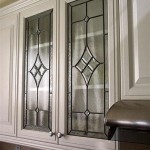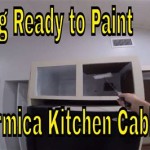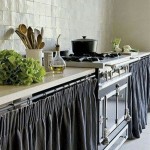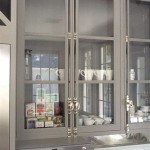How To Clean Greasy Dust On Top Of Kitchen Cabinets
The tops of kitchen cabinets are notorious for accumulating a layer of greasy dust. This accumulation is a combination of airborne grease particles released during cooking, regular household dust, and general grime. Because this surface is often out of sight and difficult to reach, it's easily neglected. However, regular cleaning can prevent a thick, stubborn buildup that becomes increasingly challenging to remove. This article provides a comprehensive guide to effectively cleaning greasy dust from the tops of kitchen cabinets, outlining the necessary tools, materials, and techniques.
Preparation and Safety Measures
Before commencing the cleaning process, it is essential to gather the necessary supplies and implement appropriate safety precautions. Proper preparation will streamline the task and minimize potential hazards.
Gathering Supplies: The following items will be required for effective and safe cleaning:
- Cleaning Solutions: Degreasers, all-purpose cleaners, dish soap, and baking soda are all effective options. Choose a cleaner appropriate for the cabinet material (e.g., wood, laminate, metal). A combination of these cleaners may be necessary depending on the severity of the grease buildup.
- Cleaning Tools: Microfiber cloths, sponges, scrub brushes (non-abrasive), and a vacuum cleaner with a brush attachment are essential for removing dust and grime. A long-handled duster can also be helpful for reaching difficult areas.
- Protective Gear: Rubber gloves are crucial for protecting hands from harsh cleaning chemicals and potential irritants. Eye protection, such as safety glasses or goggles, is recommended to prevent splashes from entering the eyes. A dust mask or respirator can also be useful, especially when dealing with significant dust buildup.
- Step Stool or Ladder: A sturdy step stool or ladder is necessary for safely reaching the tops of the cabinets. Ensure the ladder is stable and positioned on a level surface.
- Trash Bags or Buckets: Provide a receptacle for disposing of dirty cloths, cleaning solutions, and loose debris.
- Drop Cloths or Old Sheets: Protect countertops, appliances, and floors from drips and spills by covering them with drop cloths or old sheets.
Safety Precautions: Prioritize safety to prevent accidents and injuries.
- Ventilation: Ensure adequate ventilation by opening windows and doors to allow fresh air circulation. This is especially important when using chemical cleaners.
- Ladder Safety: Always maintain three points of contact when climbing a ladder (two hands and one foot, or two feet and one hand). Avoid overreaching and move the ladder as needed.
- Chemical Safety: Read and follow the manufacturer's instructions for all cleaning products. Avoid mixing different cleaning solutions, as this can create hazardous fumes. Test any cleaning solution on an inconspicuous area of the cabinet to ensure it does not damage the finish.
- Electrical Safety: Be mindful of any electrical outlets or appliances near the cabinets. Avoid spraying cleaning solutions directly onto electrical components.
Effective Cleaning Techniques
The key to successfully cleaning greasy dust from the tops of kitchen cabinets lies in employing effective cleaning techniques. The optimal approach will depend on the severity of the buildup and the material of the cabinets.
Initial Dust Removal: Begin by removing loose dust and debris. This step will prevent the dust from becoming more deeply embedded in the grease during the cleaning process.
- Vacuuming: Use a vacuum cleaner with a brush attachment to gently remove loose dust and particles. Pay close attention to corners and crevices where dust tends to accumulate.
- Dusting: Alternatively, use a long-handled duster to sweep away loose dust. Shake the duster outdoors to remove accumulated dust.
Applying Cleaning Solutions: Once the loose dust has been removed, apply a cleaning solution to break down the grease.
- Degreaser: Commercial degreasers are specifically formulated to dissolve grease and grime. Follow the manufacturer's instructions for application and dwell time. Spray the degreaser onto a microfiber cloth and wipe the cabinet surface. Avoid spraying directly onto cabinets, as overspray can damage the finish or seep into cracks.
- All-Purpose Cleaner: All-purpose cleaners can be effective for light grease buildup. Dilute the cleaner according to the manufacturer's instructions and apply it to a microfiber cloth. Wipe the cabinet surface thoroughly.
- Dish Soap Solution: A solution of warm water and mild dish soap is a gentle yet effective cleaning option. Mix a few drops of dish soap into a bucket of warm water. Dip a microfiber cloth into the solution, wring out excess water, and wipe the cabinet surface.
- Baking Soda Paste: Baking soda is a natural abrasive that can help loosen stubborn grease. Mix baking soda with a small amount of water to create a paste. Apply the paste to the greasy areas and allow it to sit for a few minutes before scrubbing gently with a non-abrasive scrub brush or sponge. Rinse thoroughly with a damp cloth.
Scrubbing and Wiping: After applying the cleaning solution, use a scrub brush or sponge to gently scrub the greasy areas. Avoid using abrasive scrub pads, as these can scratch the cabinet finish. Wipe the surface with a clean, damp microfiber cloth to remove the cleaning solution and loosened grease. Repeat the process as needed until the surface is clean.
Drying: Once the cabinets are clean, dry them thoroughly with a clean, dry microfiber cloth. This will prevent water spots and streaks from forming.
Preventative Measures and Maintenance
Preventing the buildup of greasy dust is more efficient than repeatedly cleaning a thick, stubborn layer. Implementing preventative measures and establishing a regular maintenance routine can significantly reduce the frequency and intensity of cleaning required.
Reduce Grease Airborne: Minimizing the amount of grease released into the air during cooking is crucial.
- Use a Range Hood: A range hood effectively vents cooking fumes and grease particles outside. Ensure the range hood is functioning properly and use it whenever cooking, especially when frying or sautéing. Clean the range hood filters regularly according to the manufacturer's instructions.
- Cover Food While Cooking: Covering pots and pans while cooking helps to contain grease splatters and reduce the amount of grease released into the air.
- Wipe Up Splatters Immediately: Clean up any grease splatters on stovetops, countertops, and backsplashes immediately after cooking. This will prevent the grease from drying and becoming more difficult to remove later.
Regular Dusting: A consistent dusting schedule can prevent dust from accumulating and combining with grease.
- Weekly Dusting: Dust the tops of the cabinets weekly with a long-handled duster or a microfiber cloth attached to an extension pole. This will remove loose dust before it has a chance to combine with grease.
Protective Barriers: Consider using protective barriers to prevent grease and dust from accumulating directly on the cabinet surfaces.
- Shelf Liner: Cover the tops of the cabinets with shelf liner. This creates a barrier that catches grease and dust, making it easier to clean. Replace the shelf liner periodically as needed.
- Newspaper or Parchment Paper: A layer of newspaper or parchment paper can also serve as a protective barrier. Replace the paper regularly as it becomes soiled.
Deep Cleaning Schedule: Even with preventative measures in place, a periodic deep cleaning will be necessary.
- Quarterly Deep Cleaning: Schedule a deep cleaning of the tops of the kitchen cabinets every three to six months. This will remove any accumulated grease and grime that has not been caught by regular dusting or protective barriers.
By implementing these preventative measures and establishing a regular maintenance routine, the accumulation of greasy dust on top of kitchen cabinets can be significantly reduced, resulting in a cleaner and more hygienic kitchen environment.

Cleaning The Tops Of Cabinets

How To Clean The Tops Of Greasy Kitchen Cabinets Secret Tip My Pinterventures

How To Clean The Tops Of Greasy Kitchen Cabinets Secret Tip My Pinterventures

Cleaning The Tops Of Cabinets

Cleaning Wood Top Cabinets In Kitchen Spring Is A Must

Cleaning The Tops Of Cabinets

How To Clean Grimy Kitchen Cabinets With 2 Ingredients

How To Clean Greasy Cabinets In Your Kitchen

How To Keep Kitchen Cabinet Tops Clean

How To Clean Kitchen Cabinets Everyday Skate
Related Posts








